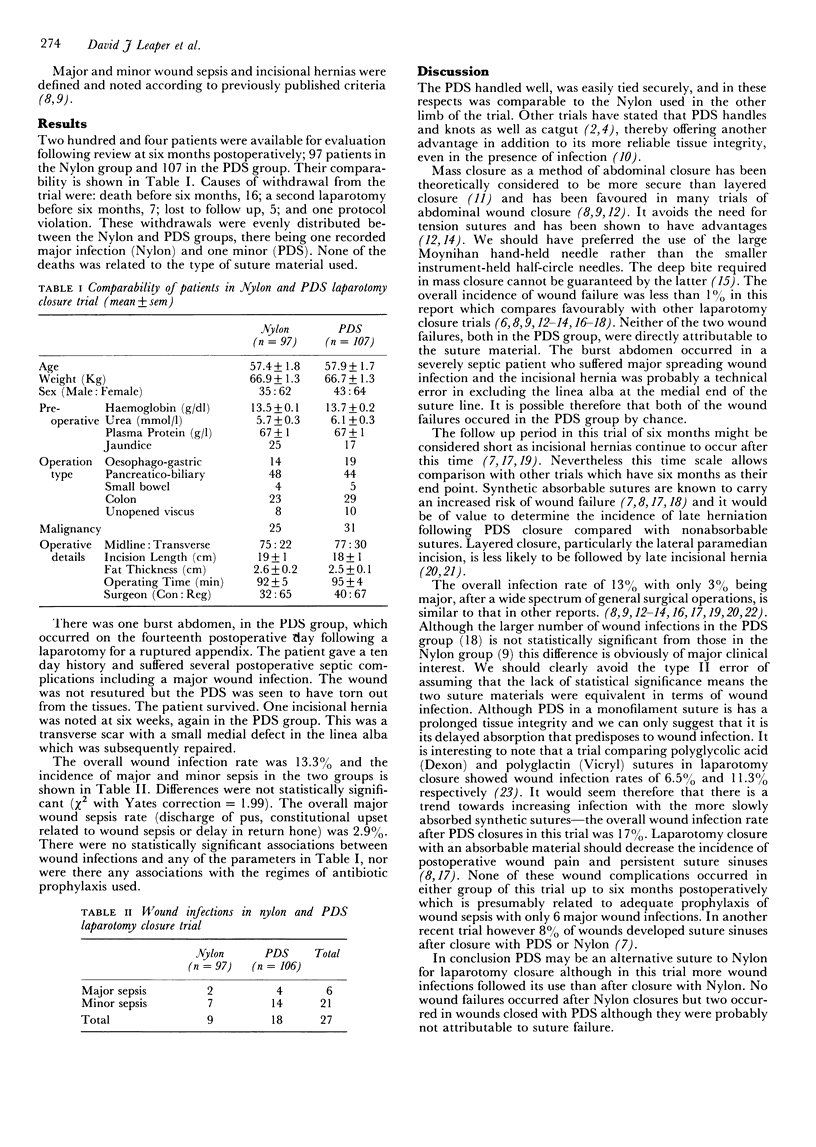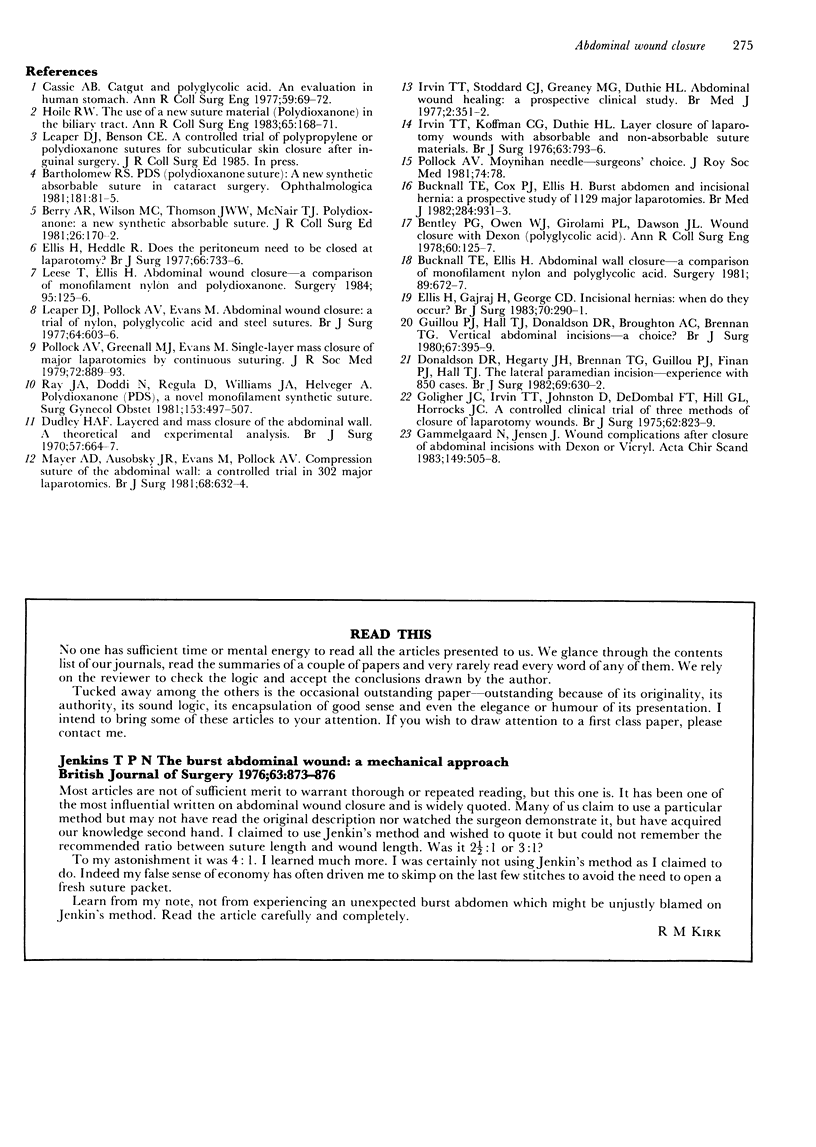Abstract
Two hundred and thirty three patients with major laparotomy wounds, either midline or transverse, were randomly allocated to mass closure using No 1 (BPC) polyamide (Nylon) or polydioxanone suture (PDS). Wounds were assessed during the hospital stay and postoperatively in outpatients, at six weeks and six months, for evidence of wound failure or wound infection. Two wound failures occurred in the PDS group (one burst abdomen and one incisional hernia) although neither was directly attributable to suture failure. The overall wound infection rate was 13.3%; 2.9% being major infections and the majority (two thirds) occurring in the PDS group. There were no reported wound sinuses or wound pain in either group at six months. Polydioxanone suture may be an alternative to polyamide for laparotomy closure but is associated with a higher, though not statistically significant, incidence of wound failure and infection.
Full text
PDF


Selected References
These references are in PubMed. This may not be the complete list of references from this article.
- Bentley P. G., Owen W. J., Girolami P. L., Dawson J. L. Wound closure with Dexon (polyglycolic acid) mass suture. Ann R Coll Surg Engl. 1978 Mar;60(2):125–127. [PMC free article] [PubMed] [Google Scholar]
- Bucknall T. E., Cox P. J., Ellis H. Burst abdomen and incisional hernia: a prospective study of 1129 major laparotomies. Br Med J (Clin Res Ed) 1982 Mar 27;284(6320):931–933. doi: 10.1136/bmj.284.6320.931. [DOI] [PMC free article] [PubMed] [Google Scholar]
- Bucknall T. E., Ellis H. Abdominal wound closure--a comparison of monofilament nylon and polyglycolic acid. Surgery. 1981 Jun;89(6):672–677. [PubMed] [Google Scholar]
- Cassie A. B. Catgut and polyglycolic acid. An evaluation in the human stomach. Ann R Coll Surg Engl. 1977 Jan;59(1):69–72. [PMC free article] [PubMed] [Google Scholar]
- Donaldson D. R., Hegarty J. H., Brennan T. G., Guillou P. J., Finan P. J., Hall T. J. The lateral paramedian incision--experience with 850 cases. Br J Surg. 1982 Oct;69(10):630–632. doi: 10.1002/bjs.1800691023. [DOI] [PubMed] [Google Scholar]
- Dudley H. A. Layered and mass closure of the abdominal wall. A theoretical and experimental analysis. Br J Surg. 1970 Sep;57(9):664–667. doi: 10.1002/bjs.1800570908. [DOI] [PubMed] [Google Scholar]
- Ellis H., Gajraj H., George C. D. Incisional hernias: when do they occur? Br J Surg. 1983 May;70(5):290–291. doi: 10.1002/bjs.1800700514. [DOI] [PubMed] [Google Scholar]
- Ellis H., Heddle R. Does the peritoneum need to be closed at laparotomy? Br J Surg. 1977 Oct;64(10):733–736. doi: 10.1002/bjs.1800641013. [DOI] [PubMed] [Google Scholar]
- Gammelgaard N., Jensen J. Wound complications after closure of abdominal incisions with Dexon or Vicryl. A randomized double-blind study. Acta Chir Scand. 1983;149(5):505–508. [PubMed] [Google Scholar]
- Goligher J. C., Irvin T. T., Johnston D., De Dombal F. T., Hill G. L., Horrocks J. C. A controlled clinical trial of three methods of closure of laparotomy wounds. Br J Surg. 1975 Oct;62(10):823–829. doi: 10.1002/bjs.1800621019. [DOI] [PubMed] [Google Scholar]
- Guillou P. J., Hall T. J., Donaldson D. R., Broughton A. C., Brennan T. G. Vertical abdominal incisions--a choice? Br J Surg. 1980 Jun;67(6):395–399. doi: 10.1002/bjs.1800670605. [DOI] [PubMed] [Google Scholar]
- Irvin T. T., Koffman C. G., Duthie H. L. Layer closure of laparotomy wounds with absorbable and non-absorbable suture materials. Br J Surg. 1976 Oct;63(10):793–796. doi: 10.1002/bjs.1800631015. [DOI] [PubMed] [Google Scholar]
- Irvin T. T., Stoddard C. J., Greaney M. G., Duthie H. L. Abdominal wound healing: a prospective clinical study. Br Med J. 1977 Aug 6;2(6083):351–352. doi: 10.1136/bmj.2.6083.351. [DOI] [PMC free article] [PubMed] [Google Scholar]
- Leaper D. J., Pollock A. V., Evans M. Abdominal wound closure: a trial of nylon, polyglycolic acid and steel sutures. Br J Surg. 1977 Aug;64(8):603–606. doi: 10.1002/bjs.1800640822. [DOI] [PubMed] [Google Scholar]
- Leese T., Ellis H. Abdominal wound closure--a comparison of monofilament nylon and polydioxanone. Surgery. 1984 Jan;95(1):125–126. [PubMed] [Google Scholar]
- Mayer A. D., Ausobsky J. R., Evans M., Pollock A. V. Compression suture of the abdominal wall: a controlled trial in 302 major laparotomies. Br J Surg. 1981 Sep;68(9):632–634. doi: 10.1002/bjs.1800680909. [DOI] [PubMed] [Google Scholar]
- Pollock A. V., Greenall M. J., Evans M. Single-layer mass closure of major laparotomies by continuous suturing. J R Soc Med. 1979 Dec;72(12):889–893. doi: 10.1177/014107687907201205. [DOI] [PMC free article] [PubMed] [Google Scholar]
- Pollock A. V. Moynihan needle--surgeons'choice. J R Soc Med. 1981 Jan;74(1):78–78. doi: 10.1177/014107688107400120. [DOI] [PMC free article] [PubMed] [Google Scholar]
- Ray J. A., Doddi N., Regula D., Williams J. A., Melveger A. Polydioxanone (PDS), a novel monofilament synthetic absorbable suture. Surg Gynecol Obstet. 1981 Oct;153(4):497–507. [PubMed] [Google Scholar]


